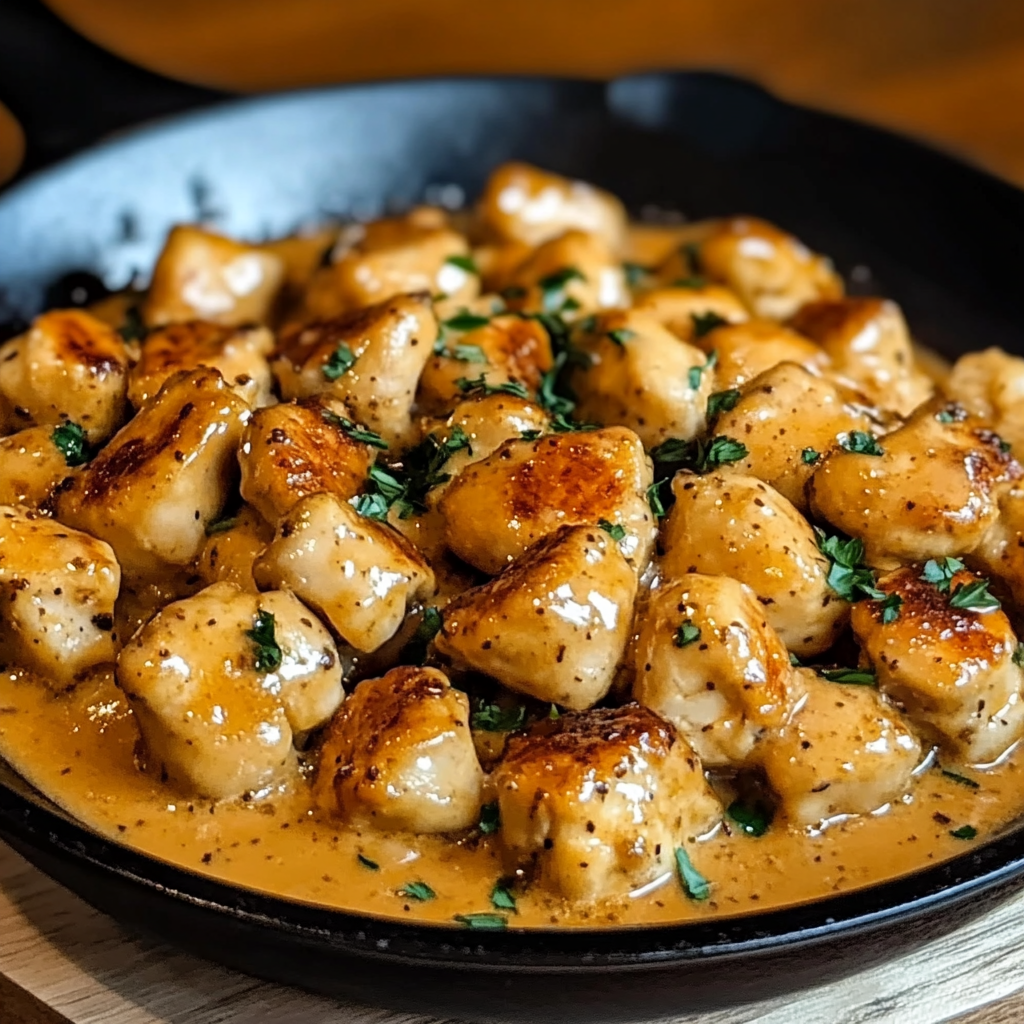Sharing is caring!
Texas Roadhouse Butter Chicken Skillet
Why You’ll Love Texas Roadhouse Butter Chicken Skillet?
If you’re craving the rich, buttery flavors of Texas Roadhouse at home, this skillet recipe is your answer. Perfect for busy weeknights or cozy weekends, this dish brings together tender chicken, creamy sauce, and warm spices in just 30 minutes. Inspired by the restaurant’s famous flavors, it’s a crowd-pleaser that pairs beautifully with fluffy bread or rice. Whether you’re a fan of bold flavors or need a quick dinner solution, this skillet meal delivers every time.
Table of Contents
- Ingredients to make Texas Roadhouse butter chicken skillet
- Time needed to make Texas Roadhouse butter chicken skillet?
- Quick Steps to Make Texas Roadhouse Butter Chicken Skillet?
- Is Texas Roadhouse butter chicken skillet healthy and nutritious ?
- Can I make Texas Roadhouse butter chicken skillet healthier and still delicious?
- How to Serve Texas Roadhouse butter chicken skillet?
- Avoid These Mistakes
- The best way to store leftover Texas Roadhouse butter chicken skillet
- Ready to give Texas Roadhouse butter chicken skillet a try?
- Frequently Asked Questions
Ingredients to make Texas Roadhouse butter chicken skillet
- 1.5 lbs boneless, skinless chicken thighs, cut into bite-sized pieces
- 2 tbsp unsalted butter
- 1 tbsp olive oil
- 1 medium onion, finely diced
- 3 garlic cloves, minced
- 1 tbsp fresh ginger, grated
- 1 tbsp garam masala
- 1 tsp ground cumin
- 1 tsp smoked paprika
- 1/2 tsp turmeric
- 1/2 tsp cayenne pepper (adjust for spice preference)
- 1 (14 oz) can crushed tomatoes
- 1/2 cup heavy cream (or coconut milk for dairy-free)
- 1 tbsp honey or brown sugar
- Salt and black pepper to taste
- Fresh cilantro, chopped (for garnish)
- Cooked basmati rice or naan (for serving)
Time needed to make Texas Roadhouse butter chicken skillet?
This Texas Roadhouse butter chicken skillet comes together in just 30 minutes, making it perfect for busy weeknights. Here’s the breakdown:
- Prep Time: 10 minutes
- Cook Time: 20 minutes
- Total Time: 30 minutes
For even faster prep, consider marinating the chicken in advance or using pre-cut veggies. If you love quick skillet meals, try our sheet pan chicken shawarma for another speedy dinner option.
Quick Steps to Make Texas Roadhouse Butter Chicken Skillet?
Step 1: Prep Your Ingredients
Gather all the ingredients for your Texas Roadhouse butter chicken skillet, ensuring everything is measured and ready to go. This includes diced chicken, spices, butter, and cream.
Step 2: Sear the Chicken
Heat a large skillet over medium-high heat. Add a tablespoon of butter and let it melt. Toss in the chicken pieces and sear until golden brown on all sides, about 5-6 minutes. Remove and set aside.
Step 3: Sauté Aromatics
In the same skillet, add more butter if needed. Toss in minced garlic, ginger, and onions. Sauté until fragrant and translucent, about 2-3 minutes.
Step 4: Add Spices & Tomato Base
Stir in garam masala, turmeric, and chili powder, letting the spices toast for 30 seconds. Pour in tomato sauce or puree, scraping any browned bits from the pan.
Step 5: Simmer the Sauce
Reduce heat to medium-low and let the sauce simmer for 5 minutes to thicken slightly. Stir occasionally to prevent sticking.
Step 6: Return Chicken & Add Cream
Add the seared chicken back into the skillet, coating it well with the sauce. Pour in heavy cream and stir gently. Let it simmer for another 5-7 minutes until the chicken is fully cooked and the sauce is rich and velvety.
Step 7: Garnish & Serve
Finish with a sprinkle of fresh cilantro and a drizzle of melted butter. Serve your Texas Roadhouse butter chicken skillet hot with naan or steamed rice. Enjoy!
Is Texas Roadhouse butter chicken skillet healthy and nutritious ?
Texas Roadhouse butter chicken skillet is a flavorful dish, but its nutritional value depends on ingredients and portion control. A standard serving contains around 450-550 calories, with 25-30g of protein from the chicken. However, the butter and cream contribute to higher fat content (20-25g per serving). For a lighter version, consider using Greek yogurt instead of heavy cream or reducing the butter.
This dish provides essential nutrients like vitamin B12 from chicken and calcium from dairy. Pair it with fiber-rich sides like roasted vegetables or a fresh salad to balance the meal. If you’re watching sodium intake, opt for low-sodium broth and spices. For more healthy chicken recipes, check out our sheet pan chicken shawarma or air fryer chicken alternatives.
For additional nutritional insights, The Stay at Home Chef offers great tips on balancing rich flavors with healthier ingredients. You might also find Cooked by Julie’s approach to protein-rich sides helpful for meal planning.
Can I make Texas Roadhouse butter chicken skillet healthier and still delicious?
Absolutely! You can enjoy a lighter version of this rich dish without sacrificing flavor. Here are some smart swaps to make your Texas Roadhouse butter chicken skillet healthier:
Healthier Ingredient Alternatives:
- Greek yogurt instead of heavy cream – adds creaminess with more protein and less fat
- Olive oil or avocado oil instead of butter – healthier fats with the same richness
- Skinless chicken thighs – leaner than traditional cuts but still juicy
- Cauliflower rice as a base – fewer carbs than regular rice
For more healthy chicken dinner ideas, check out our sheet pan chicken shawarma recipe or air fryer chicken options.
Cooking Technique Tweaks:
- Use a non-stick skillet to reduce oil needs
- Simmer longer to develop flavors without extra fat
- Add extra vegetables like spinach or bell peppers
For additional healthy cooking inspiration, explore these slow cooker techniques or quick healthy bean recipes that pair well with chicken dishes.
How to Serve Texas Roadhouse butter chicken skillet?
This rich, creamy dish pairs beautifully with warm garlic naan or fluffy basmati rice to soak up the flavorful sauce. For a lighter option, serve it alongside a crisp cucumber salad or roasted vegetables like spiced cauliflower. If you’re hosting a crowd, elevate the meal with buttery mashed potatoes or a tangy mango chutney. For drinks, try a chilled lassi or spiced chai to balance the dish’s richness.
Avoid These Mistakes
Making a Texas Roadhouse butter chicken skillet is simple, but a few missteps can affect flavor and texture. Here’s what to watch for:
Overcooking the Chicken
Chicken breasts dry out fast. Cook just until they reach 165°F internally. For juicier results, try air-frying chicken first, then adding it to the skillet.
Using Cold Butter
Room-temperature butter blends smoothly into the sauce. Cold butter can make it grainy. If you’re short on time, check this guide for quick softening tricks.
Skipping the Spice Bloom
Toasting spices in oil before adding liquids intensifies their flavor. Don’t rush this step—it’s key for that signature Texas Roadhouse depth. Pair it with a light veggie side for balance.
Overcrowding the Skillet
Browning requires space. Cook chicken in batches if needed, as shown in this quick protein technique. Crowding steams instead of sears.
The best way to store leftover Texas Roadhouse butter chicken skillet
To keep your Texas Roadhouse butter chicken skillet fresh, transfer it to an airtight container and refrigerate within two hours of cooking. It stays good for up to 3–4 days. For longer storage, freeze portions in freezer-safe bags or containers for up to 3 months. When reheating, warm it gently on the stovetop with a splash of broth or cream to restore moisture. For more tips on preserving chicken dishes, check out our guide on storing air-fryer chicken or explore creamy smothered chicken storage tricks. If you’re meal-prepping, pair it with Cuban black beans or slow-cooker beef ribs for a hearty combo.
Ready to give Texas Roadhouse butter chicken skillet a try?
This rich, flavorful dish is perfect for busy weeknights or cozy weekend dinners. With its tender chicken, creamy sauce, and buttery skillet finish, it’s a guaranteed crowd-pleaser. If you loved this recipe, check out our sheet pan chicken shawarma or air fryer chicken for more easy dinner ideas. For a comforting side, pair it with our vegetable quiche or ground turkey recipes. Don’t forget to share your creation—we’d love to hear how it turned out!
Frequently Asked Questions
Can I use boneless chicken for Texas Roadhouse butter chicken skillet?
Yes, boneless chicken thighs or breasts work perfectly. Thighs add extra juiciness, while breasts cook faster.
Is this dish spicy?
The heat level is mild but adjustable. Reduce cayenne pepper for a milder version or add extra for more kick.
Can I make this recipe dairy-free?
Absolutely! Substitute butter with olive oil and use coconut cream instead of heavy cream for a rich dairy-free alternative.
How do I prevent the sauce from curdling?
Keep heat at medium-low when adding dairy, and stir constantly. Let cream reach room temperature before incorporating.
What’s the best skillet to use?
A 12-inch cast iron or heavy-bottomed stainless steel skillet works best for even heat distribution and that authentic Texas Roadhouse sear.
Can I prepare this ahead of time?
The sauce can be made 1-2 days in advance. Reheat gently and add freshly cooked chicken when serving for best texture.











